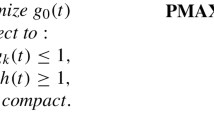Abstract
In this paper, we present an interior point algorithm for solving both convex and nonconvex quadratic programs. The method, which is an extension of our interior point work on linear programming problems efficiently solves a wide class of largescale problems and forms the basis for a sequential quadratic programming (SQP) solver for general large scale nonlinear programs. The key to the algorithm is a three-dimensional cost improvement subproblem, which is solved at every interation. We have developed an approximate recentering procedure and a novel, adaptive big-M Phase I procedure that are essential to the sucess of the algorithm. We describe the basic method along with the recentering and big-M Phase I procedures. Details of the implementation and computational results are also presented.
Similar content being viewed by others
References
P.D. Domich, P.T. Boggs, J.E. Rogers and C. Witzgall, Optimizing over three-dimensional subspaces in an interior-point method for linear programming, Linear Algebra and its Applications 152 (1991).
P.T. Boggs, P.D. Domich, J.E. Rogers and C. Witzgall, An interior point method for linear and quadratic programming problems. Mathematical Programming Society Committee on Algorithms Newsletter 19 (1991) 32–40.
P.T. Boggs, JW. Tolle and A.J. Kearsley, A practical algorithm for general large-scale nonlinear optimization problem, NISTIR 5407, National Institute of Standards and Technology (1994), to appear in SIAM Journal of Optimization.
P.T. Boggs, J.W. Tolle and A.J. Kearsley, A truncated SQP algorithm for large-scale nonlinear programming problems, in:Advances in Optimization and Numerical Analysis: Proc 6th Workshop on Optimization and Numerical Analysis, Oaxaco, Mexico (Kluwer Academic Dordrecht, The Netherlands, 1994).
R. Fletcher,Practical Methods of Optimization, 2nd ed. (Wiley, New York, 1987).
P. Huard, Resolution of mathematical programming with nonlinear constraints by the method of centres, in:Nonlinear Programming, ed. J. Abadie (North-Holland Amsterdam, 1967) pp. 209–219.
R.J. Vanderbeei, Interior-point methods: Algorithms and formulations, ORSA Journal of Computing 6 (1994) 32–34.
R.J. Vanderbei and T.J. Carpenter, Symmetric indefinite systems for interior-point methods Mathematical Programming 58 (1993) 1–32.
D.F. Shanno, private communication (1991).
K.M. Anstreicher, D. den Hertog and C. Roos, A long step barrier method for convex quadratic programming, Algorithmica 10 (1993) 365.
K.M. Anstriecher, On long step path following and SUMT for linear and quadratici programming, Manuscript, Yale School of Organization and Management (August 1990).
T.F. Coleman and J. Liu, An interior Newton method for quadratic programming, Technical Report TR 93-1388, Cornell University (October 1993).
I. Adler, M.G.C. Resende and G. Veiga, An implementatio of Karmarkar's algorithm for linear programming, Mathematical Programming 44 (1989) 297–335.
R.H.F. Jackson and G.P. McCormick, The polyadic structure of factorable function tensors with applications to higher-order minimization techniques. Journal of Optimization Theory and Applications 51 (1986) 63–93.
T. Ishihara and M. Kojima, On the bigM in the affine scaling algorithm, Mathematical Protramming 62 (1993) 85–94.
M. Kojima, S. Mizuno and A. Yoshise, A little theorem of the bigM in interior point algorithms, Mathematical Programming 59 (1993) 361–375
P.E. Gill, W. Murray and M.H. Wright,Practical Optimization (Academic Press, 1981).
A.V. Fiacco and G.P. McCormick,Nonlinear Programming Sequential Unconstrained Minimization Techniques (Wiley, New York, 1968).
J. Vlach and K. Singhal,Computer Methods for Circuit Analysis and Design (Van Nostrand Reinhold, New York, 1983).
SMPAK User's Guide Version 1.0 (1985).
P.T. Boggs, P.D. Domich, J.R. Donaldson and C. Witzgall, Algorithmic enhancements to the method of centers for linear programming, ORSA Journal on Computing 1 (1989) 159–171.
J.J. Lustig, R.E. Marsten and D.F. Shanno, Computational experience with a primal-dual interior point method for linear programming, Linear Algebra and its Applications 152 (1991) 191–222.
R.E. Marsten, M.J. Saltzman, D.F. Shanno, G.S. Pierce and J.F. Ballintijn, Implementation of a dual affine interior point algorithm for linear programmin, ORSA Journal on Computing 1 (1990) 287–297.
A. Marxen, Primal barrier methods for linear programming, Ph.D. Thesis, Department of Operations Research, Stanford University, Stanford, CA (1989).
D.M. Gay, Electronic mail distribution of linear programming test problems, Mathematical Programming Society COAL Newsletter 13 (December 1985).
Author information
Authors and Affiliations
Additional information
Contribution of the National Institute of Standards and Tedchnology and not subject to copyright in the United States. This research was supported in part by ONR Contract N-0014-87-F0053.
Rights and permissions
About this article
Cite this article
Boggs, P.T., Domich, P.D. & Rogers, J.E. An interior point method for general large-scale quadratic programming problems. Ann Oper Res 62, 419–437 (1996). https://doi.org/10.1007/BF02206825
Issue Date:
DOI: https://doi.org/10.1007/BF02206825




